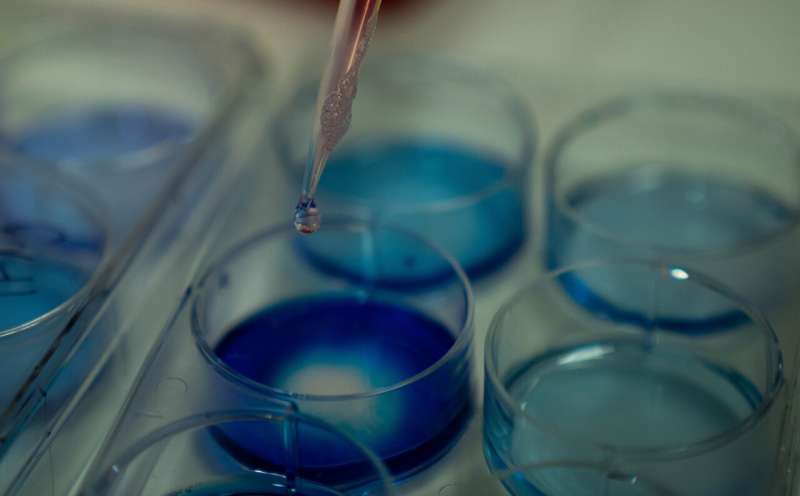This article has been reviewed according to Science X's editorial process and policies. Editors have highlighted the following attributes while ensuring the content's credibility:
fact-checked
peer-reviewed publication
trusted source
proofread
New TNIP1 mutation discovery offers fresh hope for disease that can cause blindness

An international team of scientists including researchers from The Australian National University (ANU) have identified a rare, mutated version of a protein called TNIP1 that causes a chronic autoimmune disease similar to Sjogren's Syndrome—a condition that leads to extreme dryness of the eyes and mouth that can cause blindness if left untreated.
According to the researchers, the TNIP1 mutation may also be responsible for more severe autoimmune diseases including lupus, a debilitating condition that causes inflammation in organs and joints, skin rashes and fatigue. In extreme cases, the disease can be fatal.
The scientists say they were able to successfully reverse the damaging effects of the mutation in mice, bringing them a step closer to developing new drug therapies that do the same in humans.
The findings could lead to new and tailored treatments for Sjogren's Syndrome and lupus that is caused by TNIP1 variants. The paper is published in the journal Nature Immunology.
Lead author Dr. Arti Medhavy, who completed this work as part of her Ph.D. at ANU, said this is the first time scientists have shown a variation of the TNIP1 protein is responsible for causing autoimmune disease in humans.
"Proteins are critical to our growth, development and overall health, but they have a shelf life. Once the proteins have served their purpose, they become deactivated," Dr. Medhavy, who is now at Griffith University's Institute for Biomedicine and Glycomics, said.
"That's where TNIP1 comes in. It works in unison with the cell's waste management system. TNIP1 essentially acts as a gatekeeper of the immune system by removing obsolete proteins and taking them to the cell's degradation sites where they are broken down, recycled and repurposed.
"Genetic material is normally packaged within specific compartments of the cell, including the cell's energy factories which are called mitochondria. The same genetic material, however, can trigger alarms in the immune system if detected outside of these specialized compartments.
"Importantly, TNIP1's role in the waste management system includes the removal of damaged or leaky mitochondria, which helps maintain healthy cells.
"But the mutated version of the TNIP1 protein is less efficient at taking these waste proteins and mitochondria to be processed, leading to toxic build-up within cells. If this waste isn't dealt with, these materials can become detrimental to the cell and trigger the immune system, which ultimately promotes the onset of autoimmune disease."
It's believed 1 in 10 Australians are living with some form of autoimmune disease. Study co-author Dr. Vicki Athanasopoulos, from ANU, said Sjogren's Syndrome is a nasty and debilitating condition that affects more than 270,000 Australians.
She said there is a need to develop tailored treatments that specifically target the proteins and biochemical pathways that lead to the onset of autoimmune disease, rather than suppressing the entire immune system.
"There is currently no cure for autoimmune disease. Current therapies help patients better manage their condition, but these treatments have unpleasant side effects that make patients more susceptible to infection, which can lower their quality of life," Dr. Athanasopoulos said.
The researchers identified the TNIP1 mutation in two unrelated patients—one from Australia and the other from China. Despite both having the same TNIP1 mutation, one patient exhibited signs and symptoms of lupus, while the other seemed to possess symptoms of Sjogren's Syndrome.
Using gene-editing technology, the researchers introduced the human equivalent TNIP1 mutation into mice. They found that mice carrying the mutation developed a condition that mimicked the Sjogren's disease-like symptoms seen in one of the human patients.
"The TNIP1 mutant protein is similar to the lupus-causing TLR7 mutation in that it affects the same biochemical pathway. There is work already underway by pharmaceutical companies to develop new drugs and tweak existing ones that inhibit the TLR7 pathway," Dr. Athanasopoulos said.
According to Dr. Medhavy, although both patients with the TNIP1 mutation had slightly different forms of autoimmune disease, they both had abnormally high levels of IgG4 antibodies in their blood.
"The abnormally high presence of IgG4 in both patients is interesting because clinicians might be able to use IgG4 as a biomarker of TNIP1-driven autoimmune disease," she said.
"By screening patients with autoimmune disease for high levels of igG4, clinicians might be able to test whether patients also possess the TNIP1 mutation, which would indicate that they may respond well to therapies targeting the same TLR7-pathway."
More information: Arti Medhavy et al, A TNIP1-driven systemic autoimmune disorder with elevated IgG4, Nature Immunology (2024). DOI: 10.1038/s41590-024-01902-0


















